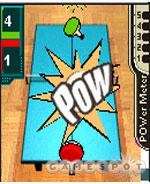Ping pong has been a part of gaming since the release of Pong, the granddaddy of all video games. Ping Pong POW tries to add special, powerful shots to the game in a bid to stand apart from other ping pong games. If you return five consecutive shots, you gain the ability to send a curving blast at your opponent that is impossible to return. This new feature turns the game into a plodding race to activate a power shot. Compared to games such as 3D Slam Ping Pong, Ping Pong POW lacks the frenetic, fast pace of a good ping pong match.

Ping Pong POW presents you with a good-looking first-person, angled perspective of a ping pong table. You control a paddle that floats above the table, and your opponent is represented by a second, different colored paddle. The 1, 2, and 3 keys let you make a shot to the far left, middle, or right, while 4, 5, and 6 allow close shots to the same areas. The game moves the paddle into position for you, but you can turn off this option to gain manual control of it. In this case, 7, 8, and 9 let you place the paddle in the left, middle, or right area of the table.
Gameplay comes down to timing. As a shot approaches you, you must hit a button for a return. If you make a shot too early or too late, your shot bounces off the net or you miss the ball. The standard game goes to 11 points.
Ping Pong POW's sound is turned off as a default setting. The sounds mimic a ping pong ball striking a table or paddle; however, the sound has some timing issues. During a volley, the ball's bouncing sound sometimes plays a half-second after it strikes the table. This proves distracting, especially since you must rely on good timing to make a shot.
Ping Pong POW's special shots cut the gameplay short, turning the game into a dull practice of hitting shots until you can make a killer, unstoppable return. The computer player seems to miss shots almost at random; therefore, you can easily rely on one shot over and over again without using a strategy. Once you have returned five shots, you can activate the power shot by pressing 0. Your next shot automatically scores a point if you manage to return it over the net.
Once you have the timing needed to make a simple return, there is little left for you to master aside from pulling your finger away from the shot button to hit 0. If you can do this fast enough to make your next return shot a power one, you can easily defeat the computer opponent.
The game's modes fail to solve this problem. You can practice against one of the five computer opponents, play a single match, or participate in a tournament. The opponents are ranked in order of difficulty, but the only thing that changes about them is their ability to make power shots. The superior opponents have the ability to make power shots seemingly at random, and unlike you, they do not need to successfully make five return shots before unleashing a power shot. Luckily, Ping Pong POW never abuses this option to simply overwhelm you. Aside from the power shots, making a successful return is easy once you have played a practice game or two. The shot's speed remains constant while the paddle automatically moves to the right position.
You can increase the game's difficulty by opting to manually control the paddle, but Ping Pong POW's controls are simply too cluttered to make this mode viable. This creates a new set of problems, as the controls are difficult to handle. Most phones--the LG VX6000 included--are too small to make it easy to use two rows of buttons at the same time, especially with two hands. If you try to use one hand for both controls, it is all too easy to accidentally hit the wrong button.
Ping Pong POW tries to add a new wrinkle to a video game classic. Unfortunately, by doing so it drains much of the fun from ping pong. Sometimes, a classic attains that status based on the strength of its basic gameplay. Ping Pong POW serves as an example of how to damage a game's core strength by adding gimmicks that work against it.